The Impact of the COVID-19 Pandemic on the Amount of Plastic Waste and Alternative Materials in the Context of the Circular Economy
Abstract
1. Introduction
- Reducing the efficiency of soil nutrient use,
- Introducing pollutants (microplastics) into agricultural products,
- Increase in morbidity in society,
- Increase in ecological problems.
2. COVID—Problem with Waste Management
3. New Materials as a Way to Solve the Problem
Biodegradbale Materials
4. Materials and Methods
- Filament extrusion.
- Filament drawing.
- Filament deposition.
5. Results and Discussion
6. Conclusions
Author Contributions
Funding
Institutional Review Board Statement
Informed Consent Statement
Data Availability Statement
Acknowledgments
Conflicts of Interest
References
- Proshad, R.; Kormoker, T.; Islam, M.S.; Haque, M.A.; Rahman, M.M.; Mithu, M.M.R. Toxic Effects of Plastic on Human Health and Environment: A Consequences of Health Risk Assessment in Bangladesh. Int. J. Health 2017, 6, 1. [Google Scholar] [CrossRef]
- Leal Filho, W.; Saari, U.; Fedoruk, M.; Iital, A.; Moora, H.; Klöga, M.; Voronova, V. An Overview of the Problems Posed by Plastic Products and the Role of Extended Producer Responsibility in Europe. J. Clean. Prod. 2019, 214, 550–558. [Google Scholar] [CrossRef]
- Adeniran, A.A.; Shakantu, W. The Health and Environmental Impact of Plastic Waste Disposal in South African Townships: A Review. Int. J. Environ. Res. Public Health 2022, 19, 779. [Google Scholar] [CrossRef]
- Madej-Kiełbik, L.; Gzyra-Jagieła, K.; Jóźwik-Pruska, J.; Wiśniewskia-Wrona, M.; Dymel, M. Biodegradable Nonwoven Materials with Antipathogenic Layer. Environments 2022, 9, 79. [Google Scholar] [CrossRef]
- Solutions for Plastic Pollution. Nat. Geosci. 2023, 16, 655. [CrossRef]
- 8.3 Billion Tonnes of Plastic Produced since 1950, Say Researchers. Available online: https://resource.co/article/83-billion-tonnes-plastic-produced-1950-say-researchers-11997 (accessed on 1 December 2023).
- Just 9% of Discarded Plastic Recycled since 1950s. Available online: https://www.iema.net/articles/just-9-of-discarded-plastic-recycled-since-1950s (accessed on 1 December 2023).
- Aizudin, M.; Goei, R.; Ong, A.J.; Tan, Y.Z.; Lua, S.K.; Poolamuri Pottammel, R.; Geng, H.; Wu, X.L.; Yoong Tok, A.L.; Ang, E.H. Sustainable Development of Graphitic Carbon Nanosheets from Plastic Wastes with Efficient Photothermal Energy Conversion for Enhanced Solar Evaporation. J. Mater. Chem. A Mater. 2022, 10, 19612–19617. [Google Scholar] [CrossRef]
- Kumi-Larbi Jnr, A.; Galpin, R.; Manjula, S.; Lenkiewicz, Z.; Cheeseman, C. Reuse of Waste Plastics in Developing Countries: Properties of Waste Plastic-Sand Composites. Waste Biomass Valorization 2022, 13, 3821–3834. [Google Scholar] [CrossRef]
- Gbadeyan, O.J.; Fagbemi, O.D.; Andrew, J.; Adali, S.; Glen, B.; Sithole, B. Cellulose Nanocrystals and Snail Shell-Reinforced Polyvinyl Alcohol Bioplastic Films: Additive Concentration Optimization and Mechanical Properties Assessment. J. Appl. Polym. Sci. 2022, 139, e52839. [Google Scholar] [CrossRef]
- Gbadeyan, O.J.; Linganiso, L.Z.; Deenadayalu, N. Thermomechanical Characterization of Bioplastic Films Produced Using a Combination of Polylactic Acid and Bionano Calcium Carbonate. Sci. Rep. 2022, 12, 15538. [Google Scholar] [CrossRef]
- Qin, M.; Chen, C.; Song, B.; Shen, M.; Cao, W.; Yang, H.; Zeng, G.; Gong, J. A Review of Biodegradable Plastics to Biodegradable Microplastics: Another Ecological Threat to Soil Environments? J. Clean. Prod. 2021, 312, 127816. [Google Scholar] [CrossRef]
- Li, N.; Liu, H.; Cheng, Z.; Yan, B.; Chen, G.; Wang, S. Conversion of Plastic Waste into Fuels: A Critical Review. J. Hazard. Mater. 2022, 424, 127460. [Google Scholar] [CrossRef]
- Gigault, J.; Halle, A.T.; Baudrimont, M.; Pascal, P.Y.; Gauffre, F.; Phi, T.L.; El Hadri, H.; Grassl, B.; Reynaud, S. Current Opinion: What Is a Nanoplastic? Environ. Pollut. 2018, 235, 1030–1034. [Google Scholar] [CrossRef]
- Bakir, A.; Rowland, S.J.; Thompson, R.C. Enhanced Desorption of Persistent Organic Pollutants from Microplastics under Simulated Physiological Conditions. Environ. Pollut. 2014, 185, 16–23. [Google Scholar] [CrossRef]
- Avio, C.G.; Gorbi, S.; Regoli, F. Experimental Development of a New Protocol for Extraction and Characterization of Microplastics in Fish Tissues: First Observations in Commercial Species from Adriatic Sea. Mar. Environ. Res. 2015, 111, 18–26. [Google Scholar] [CrossRef]
- Peng, L.; Fu, D.; Qi, H.; Lan, C.Q.; Yu, H.; Ge, C. Micro- and Nano-Plastics in Marine Environment: Source, Distribution and Threats—A Review. Sci. Total Environ. 2020, 698, 134254. [Google Scholar] [CrossRef]
- Li, W.C.; Tse, H.F.; Fok, L. Plastic Waste in the Marine Environment: A Review of Sources, Occurrence and Effects. Sci. Total Environ. 2016, 566–567, 333–349. [Google Scholar] [CrossRef]
- Kolandhasamy, P.; Su, L.; Li, J.; Qu, X.; Jabeen, K.; Shi, H. Adherence of Microplastics to Soft Tissue of Mussels: A Novel Way to Uptake Microplastics beyond Ingestion. Sci. Total Environ. 2018, 610–611, 635–640. [Google Scholar] [CrossRef] [PubMed]
- Gatto, V.; Conca, S.; Bardella, N.; Beghetto, V. Efficient Triazine Derivatives for Collagenous Materials Stabilization. Materials 2021, 14, 3069. [Google Scholar] [CrossRef] [PubMed]
- Beghetto, V.; Sole, R.; Buranello, C.; Al-Abkal, M.; Facchin, M. Recent Advancements in Plastic Packaging Recycling: A Mini-Review. Materials 2021, 14, 4782. [Google Scholar] [CrossRef] [PubMed]
- Duan, H.; Song, G.; Qu, S.; Dong, X.; Xu, M. Post-Consumer Packaging Waste from Express Delivery in China. Resour. Conserv. Recycl. 2019, 144, 137–143. [Google Scholar] [CrossRef]
- Khatoon, N.; Jamal, A.; Ali, M.I. Lignin Peroxidase Isoenzyme: A Novel Approach to Biodegrade the Toxic Synthetic Polymer Waste. Environ. Technol. 2019, 40, 1366–1375. [Google Scholar] [CrossRef]
- Payne, J.; Jones, M.D. The Chemical Recycling of Polyesters for a Circular Plastics Economy: Challenges and Emerging Opportunities. ChemSusChem 2021, 14, 4041–4070. [Google Scholar] [CrossRef]
- European Bioplastic Report 2019. In 2020—Bioplastics Market Data 2019; Global Production Capacities of Bioplastics 2019–2024: Berlin, Germany, 2020.
- Gundupalli, S.P.; Hait, S.; Thakur, A. A Review on Automated Sorting of Source-Separated Municipal Solid Waste for Recycling. Waste Manag. 2017, 60, 56–74. [Google Scholar] [CrossRef] [PubMed]
- Schwarz, A.E.; Ligthart, T.N.; Godoi Bizarro, D.; De Wild, P.; Vreugdenhil, B.; van Harmelen, T. Plastic Recycling in a Circular Economy; Determining Environmental Performance through an LCA Matrix Model Approach. Waste Manag. 2021, 121, 331–342. [Google Scholar] [CrossRef] [PubMed]
- Idumah, C.I.; Nwuzor, I.C. Novel Trends in Plastic Waste Management. SN Appl. Sci. 2019, 1, 1402. [Google Scholar] [CrossRef]
- Worrell, E.; Reuter, M. Handbook of Recycling: State-of-the-Art for Practitioners, Analysts, and Scientists (Table of Contents); Elsevier: Waltham, MA, USA, 2014. [Google Scholar]
- Bening, C.R.; Pruess, J.T.; Blum, N.U. Towards a Circular Plastics Economy: Interacting Barriers and Contested Solutions for Flexible Packaging Recycling. J. Clean. Prod. 2021, 302, 126966. [Google Scholar] [CrossRef]
- Briassoulis, D.; Pikasi, A.; Hiskakis, M. Recirculation Potential of Post-Consumer /Industrial Bio-Based Plastics through Mechanical Recycling—Techno-Economic Sustainability Criteria and Indicators. Polym. Degrad. Stab. 2021, 183, 109217. [Google Scholar] [CrossRef]
- Rafiqah, S.A.; Khalina, A.; Harmaen, A.S.; Tawakkal, I.A.; Zaman, K.; Asim, M.; Nurrazi, M.N.; Lee, C.H. A Review on Properties and Application of Bio-Based Poly(Butylene Succinate). Polymers 2021, 13, 1436. [Google Scholar] [CrossRef] [PubMed]
- Saratale, R.G.; Cho, S.K.; Ghodake, G.S.; Shin, H.S.; Saratale, G.D.; Park, Y.; Lee, H.S.; Bharagava, R.N.; Kim, D.S. Utilization of Noxious Weed Water Hyacinth Biomass as a Potential Feedstock for Biopolymers Production: A Novel Approach. Polymers 2020, 12, 1704. [Google Scholar] [CrossRef]
- Liu, L.; Yu, J.; Cheng, L.; Qu, W. Mechanical Properties of Poly(Butylene Succinate) (PBS) Biocomposites Reinforced with Surface Modified Jute Fibre. Compos. Part. A Appl. Sci. Manuf. 2009, 40, 669–674. [Google Scholar] [CrossRef]
- Zeng, J.B.; Li, Y.D.; Zhu, Q.Y.; Yang, K.K.; Wang, X.L.; Wang, Y.Z. A Novel Biodegradable Multiblock Poly(Ester Urethane) Containing Poly(l-Lactic Acid) and Poly(Butylene Succinate) Blocks. Polymer 2009, 50, 1178–1186. [Google Scholar] [CrossRef]
- Thurber, H.; Curtzwiler, G.W. Suitability of Poly(Butylene Succinate) as a Coating for Paperboard Convenience Food Packaging. Int. J. Biobased Plast. 2020, 2, 1–12. [Google Scholar] [CrossRef]
- Al Battashi, H.; Al-Kindi, S.; Gupta, V.K.; Sivakumar, N. Polyhydroxyalkanoate (PHA) Production Using Volatile Fatty Acids Derived from the Anaerobic Digestion of Waste Paper. J. Polym. Environ. 2021, 29, 250–259. [Google Scholar] [CrossRef]
- Ganesh Saratale, R.; Cho, S.K.; Dattatraya Saratale, G.; Kadam, A.A.; Ghodake, G.S.; Kumar, M.; Naresh Bharagava, R.; Kumar, G.; Su Kim, D.; Mulla, S.I.; et al. A Comprehensive Overview and Recent Advances on Polyhydroxyalkanoates (PHA) Production Using Various Organic Waste Streams. Bioresour. Technol. 2021, 325, 124685. [Google Scholar] [CrossRef] [PubMed]
- Anjum, A.; Zuber, M.; Zia, K.M.; Noreen, A.; Anjum, M.N.; Tabasum, S. Microbial Production of Polyhydroxyalkanoates (PHAs) and Its Copolymers: A Review of Recent Advancements. Int. J. Biol. Macromol. 2016, 89, 161–174. [Google Scholar] [CrossRef] [PubMed]
- Sauve, G.; Van Acker, K. The Environmental Impacts of Municipal Solid Waste Landfills in Europe: A Life Cycle Assessment of Proper Reference Cases to Support Decision Making. J. Environ. Manag. 2020, 261, 110216. [Google Scholar] [CrossRef] [PubMed]
- Chen, Z.; Feng, Q.; Yue, R.; Chen, Z.; Moselhi, O.; Soliman, A.; Hammad, A.; An, C. Construction, Renovation, and Demolition Waste in Landfill: A Review of Waste Characteristics, Environmental Impacts, and Mitigation Measures. Environ. Sci. Pollut. Res. 2022, 29, 46509–46526. [Google Scholar] [CrossRef] [PubMed]
- Agarwal, S. Biodegradable Polymers: Present Opportunities and Challenges in Providing a Microplastic-Free Environment. Macromol. Chem. Phys. 2020, 221, 2000017. [Google Scholar] [CrossRef]
- Phiri, R.; Mavinkere Rangappa, S.; Siengchin, S.; Oladijo, O.P.; Dhakal, H.N. Development of Sustainable Biopolymer-Based Composites for Lightweight Applications from Agricultural Waste Biomass: A Review. Adv. Ind. Eng. Polym. Res. 2023, 6, 436–450. [Google Scholar] [CrossRef]
- Teles, F.; Antunes, F. Biopolymers as Alternatives to Synthetic Polymers in Flame-Retarded Polymeric Composites: A Study of Fire and Mechanical Behaviors. J. Vinyl Addit. Technol. 2023, 29, 120–129. [Google Scholar] [CrossRef]
- Jeevanandam, J.; Pan, S.; Rodrigues, J.; Elkodous, M.A.; Danquah, M.K. Medical Applications of Biopolymer Nanofibers. Biomater. Sci. 2022, 10, 4107–4118. [Google Scholar] [CrossRef]
- Kabir, E.; Kaur, R.; Lee, J.; Kim, K.H.; Kwon, E.E. Prospects of Biopolymer Technology as an Alternative Option for Non-Degradable Plastics and Sustainable Management of Plastic Wastes. J. Clean. Prod. 2020, 258, 120536. [Google Scholar] [CrossRef]
- Siracusa, V.; Blanco, I. Bio-Polyethylene (Bio-PE), Bio-Polypropylene (Bio-PP) and Bio-Poly(Ethylene Terephthalate) (Bio-PET): Recent Developments in Bio-Based Polymers Analogous to Petroleum-Derived Ones for Packaging and Engineering Applications. Polymers 2020, 12, 1641. [Google Scholar] [CrossRef]
- Yashas, Y.G.; Ballupete Nagaraju, S.; Puttegowda, M.; Verma, A.; Rangappa, S.M.; Siengchin, S. Biopolymer-Based Composites: An Eco-Friendly Alternative from Agricultural Waste Biomass. J. Compos. Sci. 2023, 7, 242. [Google Scholar] [CrossRef]
- Badrkhani, P. Pros and Cons of COVID-19 in Iran: How Coronavirus Outbreak Has Affected Culture and Living Style of People of This Ancient Land. J. Hum. Behav. Soc. Environ. 2021, 31, 340–352. [Google Scholar] [CrossRef]
- Tworzywa—Fakty w Pigułce 2023. Available online: https://plasticseurope.org/pl/knowledge-hub/tworzywa-fakty-w-pigulce-2023/ (accessed on 28 November 2023).
- Nanehkaran, Y.A.; Licai, Z.; Azarafza, M.; Talaei, S.; Jinxia, X.; Chen, J.; Derakhshani, R. The Predictive Model for COVID-19 Pandemic Plastic Pollution by Using Deep Learning Method. Sci. Rep. 2023, 13, 4126. [Google Scholar] [CrossRef] [PubMed]
- Mentes, M. Sustainable Development Economy and the Development of Green Economy in the European Union. Energy Sustain. Soc. 2023, 13, 1–18. [Google Scholar] [CrossRef]
- Khan, I.; Shah, D.; Shah, S.S. COVID-19 Pandemic and Its Positive Impacts on Environment: An Updated Review. Int. J. Environ. Sci. Technol. 2021, 18, 521–530. [Google Scholar] [CrossRef] [PubMed]
- 3 Mln Masek Na Minutę Pandemia Śmieci. Available online: https://www.pressreader.com/poland/gazeta-wyborcza-0557/20210419/281762747089646 (accessed on 28 December 2023).
- Du, H.; Xie, Y.; Wang, J. Microplastic Degradation Methods and Corresponding Degradation Mechanism: Research Status and Future Perspectives. J. Hazard. Mater. 2021, 418, 126377. [Google Scholar] [CrossRef] [PubMed]
- Cook, T.M. Personal Protective Equipment during the Coronavirus Disease (COVID) 2019 Pandemic—A Narrative Review. Anaesthesia 2020, 75, 920–927. [Google Scholar] [CrossRef] [PubMed]
- Martinelli, L.; Kopilaš, V.; Vidmar, M.; Heavin, C.; Machado, H.; Todorović, Z.; Buzas, N.; Pot, M.; Prainsack, B.; Gajović, S. Face Masks During the COVID-19 Pandemic: A Simple Protection Tool With Many Meanings. Front. Public Health 2021, 8, 606635. [Google Scholar] [CrossRef]
- The Face Mask Global Value Chain in the COVID-19 Outbreak: Evidence and Policy Lessons. Available online: https://www.oecd.org/coronavirus/policy-responses/the-face-mask-global-value-chain-in-the-covid-19-outbreak-evidence-and-policy-lessons-a4df866d/ (accessed on 27 December 2023).
- Venkataraman, D.; Shabani, E.; Park, J.H. Advancement of Nonwoven Fabrics in Personal Protective Equipment. Materials 2023, 16, 3964. [Google Scholar] [CrossRef]
- Liu, Y.; Jin, J.; Ma, T.; Peng, B.; Wang, X.; Yan, M. Promoting the La Solution in 2:14:1-Type Compound: Resultant Chemical Deviation and Microstructural Nanoheterogeneity. J. Mater. Sci. Technol. 2021, 62, 195–202. [Google Scholar] [CrossRef]
- Su, X.; Jia, C.; Xiang, H.; Zhu, M. Research Progress in Preparation, Properties, and Applications of Medical Protective Fiber Materials. Appl. Mater. Today 2023, 32, 101792. [Google Scholar] [CrossRef]
- Plastics Changing the Climate. Available online: https://www.planetaid.org/blog/plastics-changing-the-climate (accessed on 1 December 2023).
- Zanieczyszczenie Plastikiem to Globalny Problem! Available online: https://www.green-projects.pl/zanieczyszczenie-plastikiem-globalny-problem/ (accessed on 1 December 2023).
- Dzień Bez Opakowań Foliowych. Available online: https://www.ekokalendarz.pl/dzien-bez-opakowan-foliowych/ (accessed on 27 December 2023).
- Duszyński, J.; Afelt, A.; Ochab-Marcinek, A.; Owczuk, R.; Pyrć, K.; Rosińska, M.; Rychard, A.; Smiatacz, T. Zrozumieć COVID-19 Opracowanie Zespołus.s. COVID-19 Przy Prezesie Polskiej Akademii Nauk. Available online: https://journals.pan.pl/publication/136169/edition/119068/academia-magazyn-polskiej-akademii-nauk-2020-nr-4-64-zrozumiec-covid-19-zrozumiec-covid-19-duszynski-jerzy-afelt-aneta-ochab-marcinek-anna-owczuk-radoslaw-pyrc-krzysztof-rosinska-magdalena-rychard-andrzej-smiatacz-tomasz (accessed on 6 December 2023).
- Stawska, J.; Jabłońska, M. Determinants of Inclusive Growth in the Context of the Theory of Sustainable Finance in the European Union Countries. Sustainability 2022, 14, 100. [Google Scholar] [CrossRef]
- Jabłońska, M.; Stawska, J.; Dziuba, R.; Tekce, M.; Krasoń, M. Public Aid and Entrepreneurship During the COVID-19 Pandemic in the European Union Countries. Finans. I Prawo Finans. 2021, 3, 57–77. [Google Scholar] [CrossRef]
- Nofal, R.M. Biodegradable Textiles, Recycling, and Sustainability Achievement BT. In Handbook of Biodegradable Materials; Ali, G.A.M., Makhlouf, A.S.H., Eds.; Springer International Publishing: Cham, Switzerland, 2023; pp. 1449–1485. ISBN 978-3-031-09710-2. [Google Scholar]
- Tian, W.; Huang, K.; Zhu, C.; Sun, Z.; Shao, L.; Hu, M.; Feng, X. Recent Progress in Biobased Synthetic Textile Fibers. Front. Mater. 2022, 9, 1–12. [Google Scholar] [CrossRef]
- Harsanto, B.; Primiana, I.; Sarasi, V.; Satyakti, Y. Sustainability Innovation in the Textile Industry: A Systematic Review. Sustainability 2023, 15, 1549. [Google Scholar] [CrossRef]
- United Nations Statistical Office. Glossary of Environment Statistics; United Nations: New York, NY, USA, 1997; Volume Series F, No. 67; ISBN 9211613868. [Google Scholar]
- Tatyana, P.; Chairez, I.; Poznyak, A. Biodegradation. In Ozonation and Biodegradation in Environmental Engineering; Elsevier: Amsterdam, The Netherlands, 2019; pp. 353–388. Available online: https://www.sciencedirect.com/science/article/abs/pii/B9780128128473000238?via%3Dihub (accessed on 29 November 2023)ISBN 9780128128473.
- Ramasamy, R.; Subramanian, R.B. Synthetic Textile and Microfiber Pollution: A Review on Mitigation Strategies. Environ. Sci. Pollut. Res. 2021, 28, 41596–41611. [Google Scholar] [CrossRef] [PubMed]
- Yeo, J.C.C.; Muiruri, J.K.; Thitsartarn, W.; Li, Z.; He, C. Recent Advances in the Development of Biodegradable PHB-Based Toughening Materials: Approaches, Advantages and Applications. Mater. Sci. Eng. C 2018, 92, 1092–1116. [Google Scholar] [CrossRef] [PubMed]
- Egan, J.; Salmon, S. Strategies and Progress in Synthetic Textile Fiber Biodegradability; Springer International Publishing: Berlin/Heidelberg, Germany, 2022; Volume 4, ISBN 0123456789. [Google Scholar]
- Guzman, A.; Gnutek, N.; Janik, H. Biodegradable Polymers for Food Packaging–Factors Influencing Their Degradation and Certification Types–A Comprehensive Review. Chem. Technol. 2011, 5, 115–122. [Google Scholar]
- Tonnes of COVID-19 Health Care Waste Expose Urgent Need to Improve Waste Management Systems. Available online: https://www.who.int/news/item/01-02-2022-tonnes-of-covid-19-health-care-waste-expose-urgent-need-to-improve-waste-management-systems (accessed on 29 November 2023).
- OECD 301B; Test No. 301: Ready Biodegradability, OECD Guidelines for the Testing of Chemicals, Section 3; OECD Publishing: Paris, France, 20 December 1992; Available online: https://www.oecd-ilibrary.org/environment/test-no-301-ready-biodegradability_9789264070349-en (accessed on 1 December 2023).
- ISO 14852:2021; Determination of the Ultimate Aerobic Biodegradability of Plastic Materials in an Aqueous Medium—Method by Analysis of Evolved Carbon Dioxide. ISO: Geneva, Switzerland, 2021.
- ISO 14851:2019; Determination of the Ultimate Aerobic Biodegradability of Plastic Materials in an Aqueous Medium—Method by Measuring the Oxygen Demand in a Cosed Respirometer. ISO: Geneva, Switzerland, 2019.
- ADTM D5338; Standard Test Method for Determining Aerobic Biodegradation of Plastic Materials Under Controlled Composting Conditions, Incorporating Thermophilic Temperatures. ASTM International: West Conshohocken, PA, USA, 2021.
- ISO 14855:2018; Determination of the Ultimate Aerobic Biodegradability of Plastic Materials under Controlled Composting Conditions—Method by Analysis of Evolved Carbon Dioxide — Part 2: Gravimetric Measurement of Carbon Dioxide Evolved in a Laboratory-Scale Test. ISO: Geneva, Switzerland, 2018.
- EN 14046:2003; Evaluation of the Ultimate Aerobic Biodegradability and Disintegration of Packaging Materials under Controlled Composting Conditios—Method by Analysis of Released Carbon Dioxide. European Standard: Brussels, Belgium, 2003.
- EN 14995:2009; Plastics. Evaluation of Compostability. Test Scheme and Specification. European Standard: Brussels, Belgium, 2009.
- ASTM D6400-21; Standard Specification for Labelling of Plastics Designed to be Aerobically Composted in Municipal or Industrial Facilities. ASTM International: West Conshohocken, PA, USA, 2021.
- ISO 21701:2019; Textiles—Test Method for Accelerated Hydrolysis of Textile Materials and Biodegradation under Controlled Composting Conditions of the Resulting Hydrolysate. ISO: Geneva, Switzerland, 2019.
- ISO 17088:2021; Specifications for Compostable Plastics. ISO: Geneva, Switzerland, 2021.
- ISO 17556:2019; Plastics—Determination of the Ultimate Aerobic Biodegradability of Plastic Materials in Soil by Measuring the Oxygen Demand in a Respirometer or the Amount of Carbon Dioxide Evolved. ISO: Geneva, Switzerland, 2019.
- DIN EN ISO 11721-1:2001; Textiles—Determination of Resistance of Cellulose-Containing Textiles to Micro-Organisms—Soil Burial Test—Part 1: Assessment of Rot-Retardant Finishing. European Standard: Brussels, Belgium, 2001.
- Twarowska-Schmidt, K.; Tomaszewski, W. Evaluation of the Suitability of Selected Aliphatic Polyester Blends for Biodegradable Fibrous Materials with Improved Elasticity. Fibres Text. East. Eur. 2008, 16, 68. [Google Scholar]
- Twarowska-Schmidt, K.; Sulak, K.; Gałęski, A.; Piórkowska, E.; Wojtczak, M.; Dutkiewicz, S. Investigation on the Melt Processing of Biodegradable Aliphatic-Aromatic Polyester into Fibrous Products. Fibres Text. East. Eur. 2016, 24, 58–64. [Google Scholar] [CrossRef]
- Midha, V.K.; Dakuri, A. Spun Bonding Technology and Fabric Properties: A Review. J. Text. Eng. Fash. Technol. 2017, 1, 126–133. [Google Scholar] [CrossRef]
- Santos, A.S.; Ferreira, P.J.T.; Maloney, T. Bio-Based Materials for Nonwovens. Cellulose 2021, 28, 8939–8969. [Google Scholar] [CrossRef]
- Höhnemann, T.; Schnebele, J.; Arne, W.; Windschiegl, I. Nanoval Technology—An Intermediate Process between Meltblown and Spunbond. Materials 2023, 16, 2932. [Google Scholar] [CrossRef]
- EN ISO 10993-5:2009; Biological Evaluation of Medical Devices Part. 5: Tests for In Vitro Cytotoxicity. ISO: Geneva, Switzerland, 2009.
- PN-EN ISO 139:2006; Textile—Normal Climates for Acclimatization and Research. PKN: Warszawa, Poland, 2006.
- PN-EN 29073-1:1994; Textiles—Test Methods for Nonwoven—Determination of Surface Density. PKN: Warszawa, Poland, 1994.
- PN-EN 29073-3:1994; Textiles—Test Methods for Nonwoven—Determination of Tensile Strength and Elongation at Break. PKN: Warszawa, Poland, 1994.
- Rahman, M.Z.; Hoque, M.E.; Alam, M.R.; Rouf, M.A.; Khan, S.I.; Xu, H.; Ramakrishna, S. Face Masks to Combat Coronavirus (COVID-19)—Processing, Roles, Requirements, Efficacy, Risk and Sustainability. Polymers 2022, 14, 1296. [Google Scholar] [CrossRef] [PubMed]
- Yongmeng Zhang Wenhua Ma, M.L.H.Q.; Zhang, C. Preparation of PLA-Based SMS Nonwoven Composites and Its Applications in Protective Apparel. J. Text. Inst. 2023, 0, 1–9. [Google Scholar] [CrossRef]
- Adanur, S.; Jayswal, A. Filtration Mechanisms and Manufacturing Methods of Face Masks: An Overview. J. Ind. Text. 2022, 51, 3683S–3717S. [Google Scholar] [CrossRef]
- Sarioglu, E.; Kaynak, H.K.; Çelik, H.; Vuruşkan, D. The Tensile and Bursting Strength Evaluation of Linear Low Density Polyethylene (LLDPE) Spunbond Fabrics. In Proceedings of the Conference: ICETI 2018, Prague, Czech Republic, 21–22 November 2018. [Google Scholar]
- PP Spunbond Nonwoven Fabric. Available online: https://www.singhalglobal.com/products/pp-spunbond-nonwoven-fabric#specification (accessed on 28 December 2023).
- Nonwoven Fabric Weight: Factors to Consider When Choosing Nonwovens. Available online: https://www.milmar.cz/eng/news/59-industry-insight/142-nonwoven-fabric-weight-factors-to-consider-when-choosing-nonwovens (accessed on 28 December 2023).
- Szuman, K.; Krucińska, I.; Boguń, M.; Draczyński, Z. PLA/PHA-Biodegradable Blends for Pneumothermic Fabrication of Nonwovens. Autex Res. J. 2016, 16, 119–127. [Google Scholar] [CrossRef]
- Santonja-Blasco, L.; Ribes-Greus, A.; Alamo, R.G. Comparative Thermal, Biological and Photodegradation Kinetics of Polylactide and Effect on Crystallization Rates. Polym. Degrad. Stab. 2013, 98, 771–784. [Google Scholar] [CrossRef]
- Nelson, T.F.; Baumgartner, R.; Jaggi, M.; Bernasconi, S.M.; Battagliarin, G.; Sinkel, C.; Künkel, A.; Kohler, H.P.E.; McNeill, K.; Sander, M. Biodegradation of Poly(Butylene Succinate) in Soil Laboratory Incubations Assessed by Stable Carbon Isotope Labelling. Nat. Commun. 2022, 13, 5691. [Google Scholar] [CrossRef]
- Kim, S.H.; Cho, J.Y.; Cho, D.H.; Jung, H.J.; Kim, B.C.; Bhatia, S.K.; Park, S.H.; Park, K.; Yang, Y.H. Acceleration of Polybutylene Succinate Biodegradation by Terribacillus Sp. JY49 Isolated from a Marine Environment. Polymers 2022, 14, 3978. [Google Scholar] [CrossRef]
- Jamaluddin, N.; Razaina, M.T.; Ishak, Z.A.M. Mechanical and Morphology Behaviours of Polybutylene (Succinate)/Thermoplastic Polyurethaneblend. Procedia Chem. 2016, 19, 426–432. [Google Scholar] [CrossRef]
- Sheikholeslami, S.N.; Rafizadeh, M.; Taromi, F.A.; Shirali, H.; Jabbari, E. Material Properties of Degradable Poly(Butylene Succinate-Co-Fumarate) Copolymer Networks Synthesized by Polycondensation of Pre-Homopolyesters. Polymer 2016, 98, 70–79. [Google Scholar] [CrossRef]
- Fotopoulou, K.N.; Karapanagioti, H.K. Degradation of Various Plastics in the Environment. In The Handbook of Environmental Chemistry; Springer: Cham, Switzerland, 2019; Volume 78, pp. 71–92. [Google Scholar] [CrossRef]
- Artham, T.; Doble, M. Biodegradation of Aliphatic and Aromatic Polycarbonates. Macromol. Biosci. 2008, 8, 14–24. [Google Scholar] [CrossRef] [PubMed]
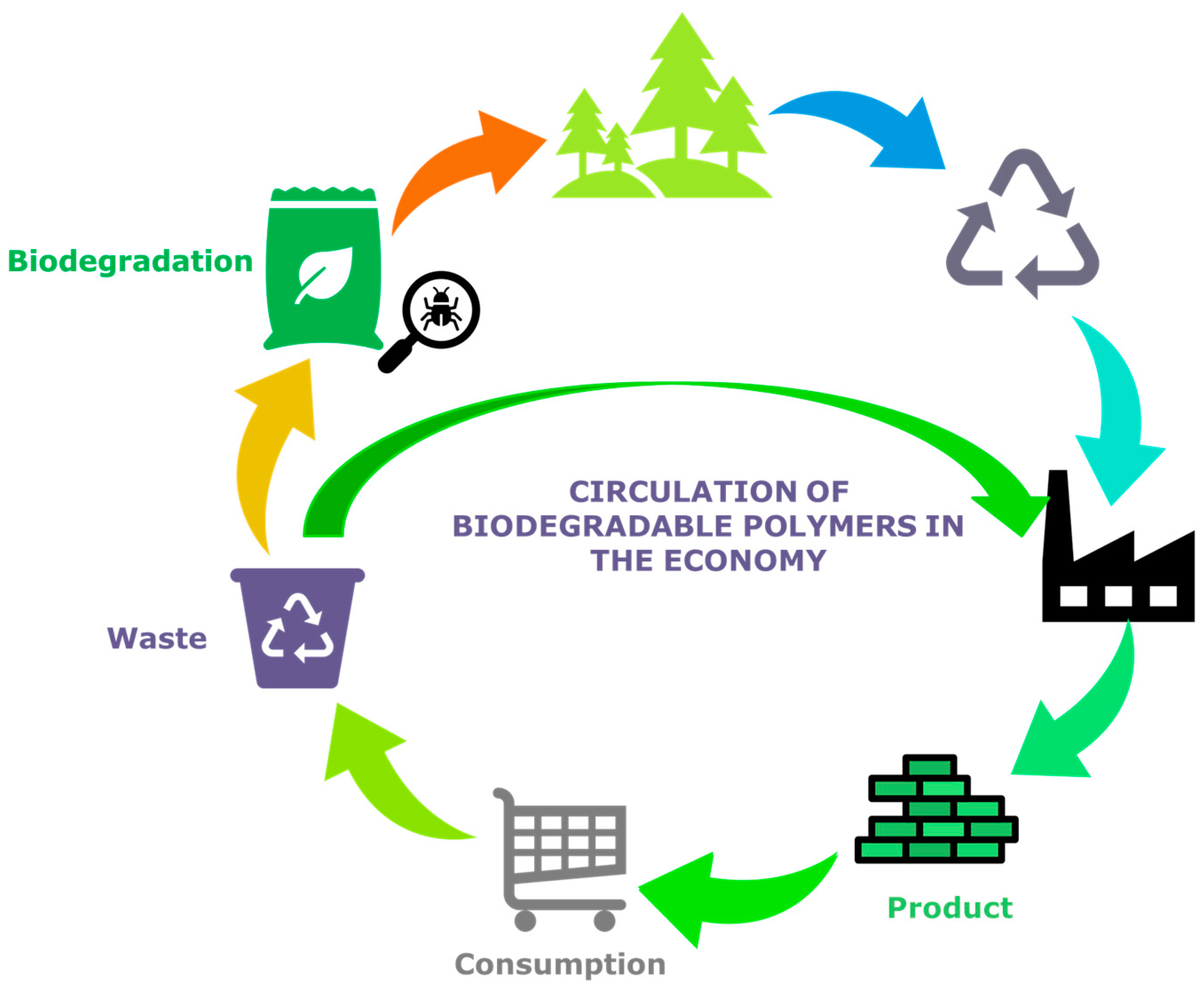
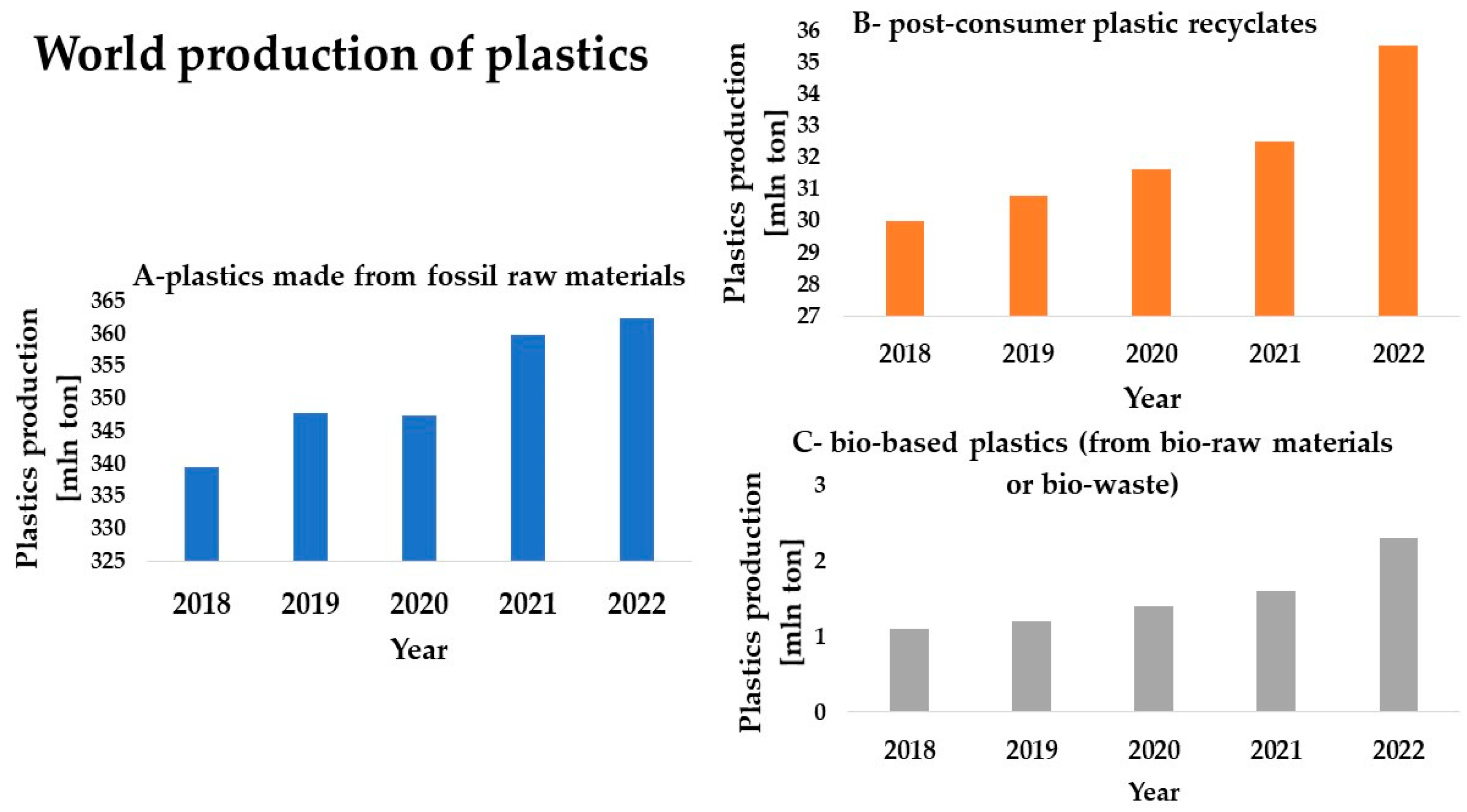
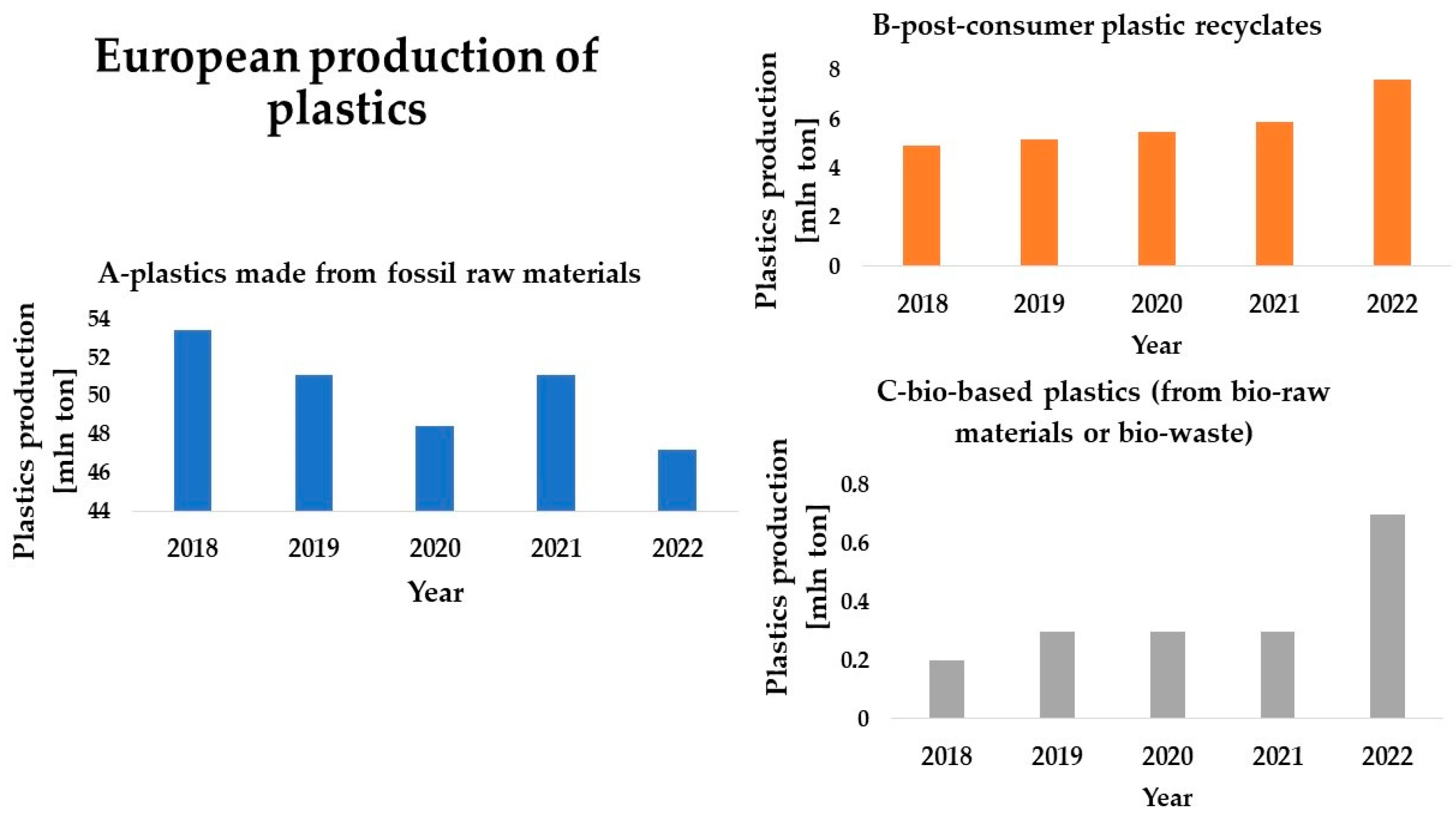
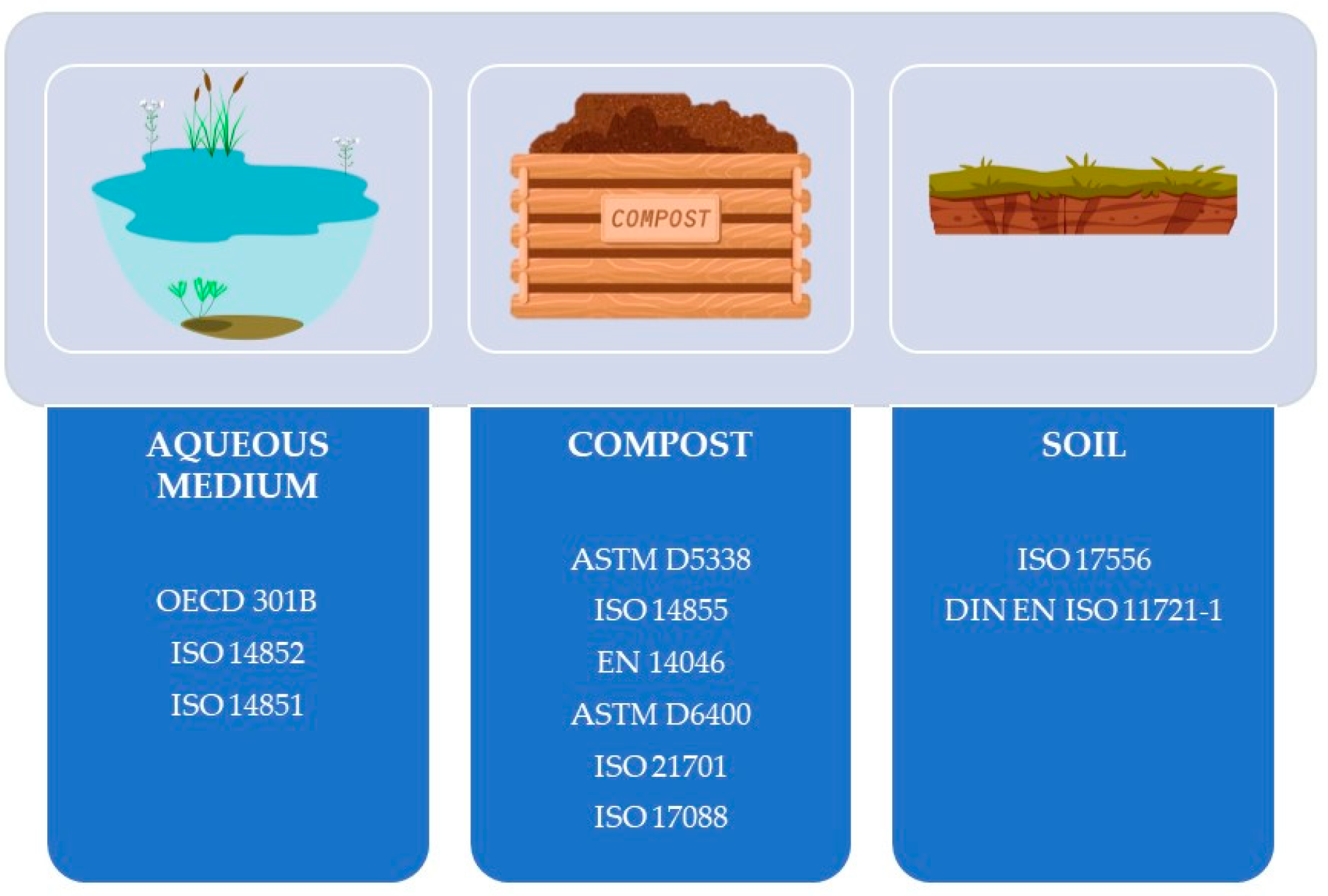


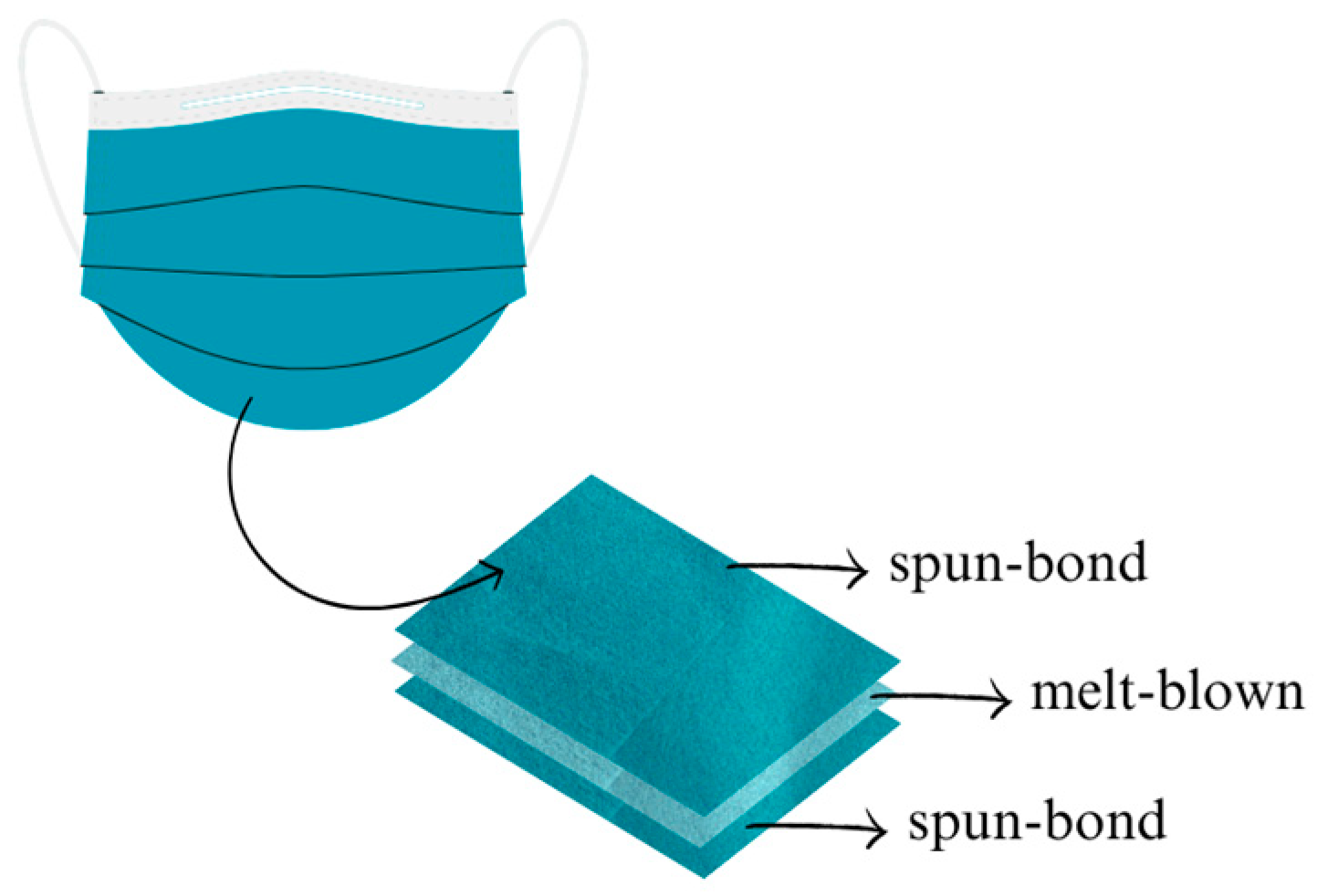
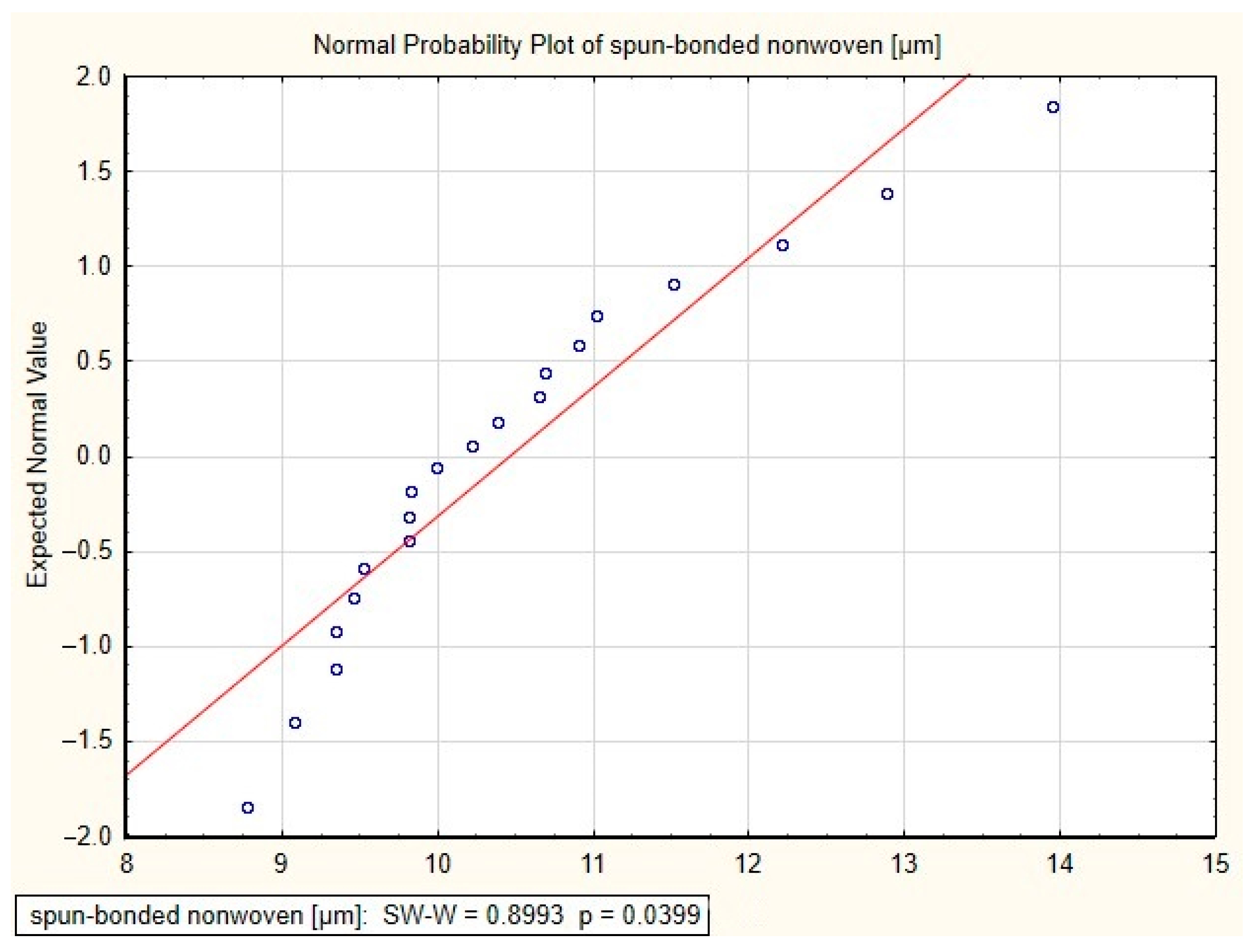
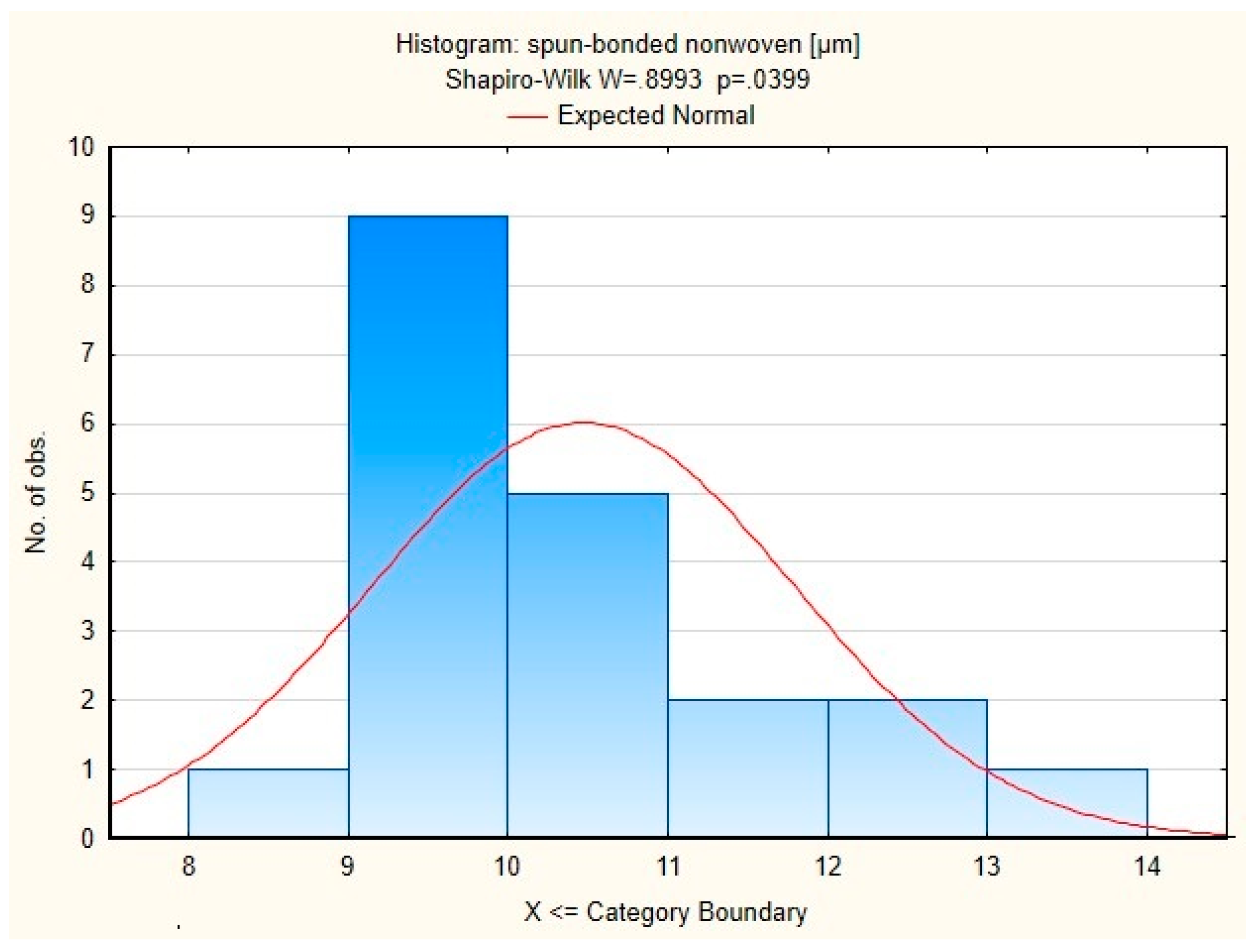
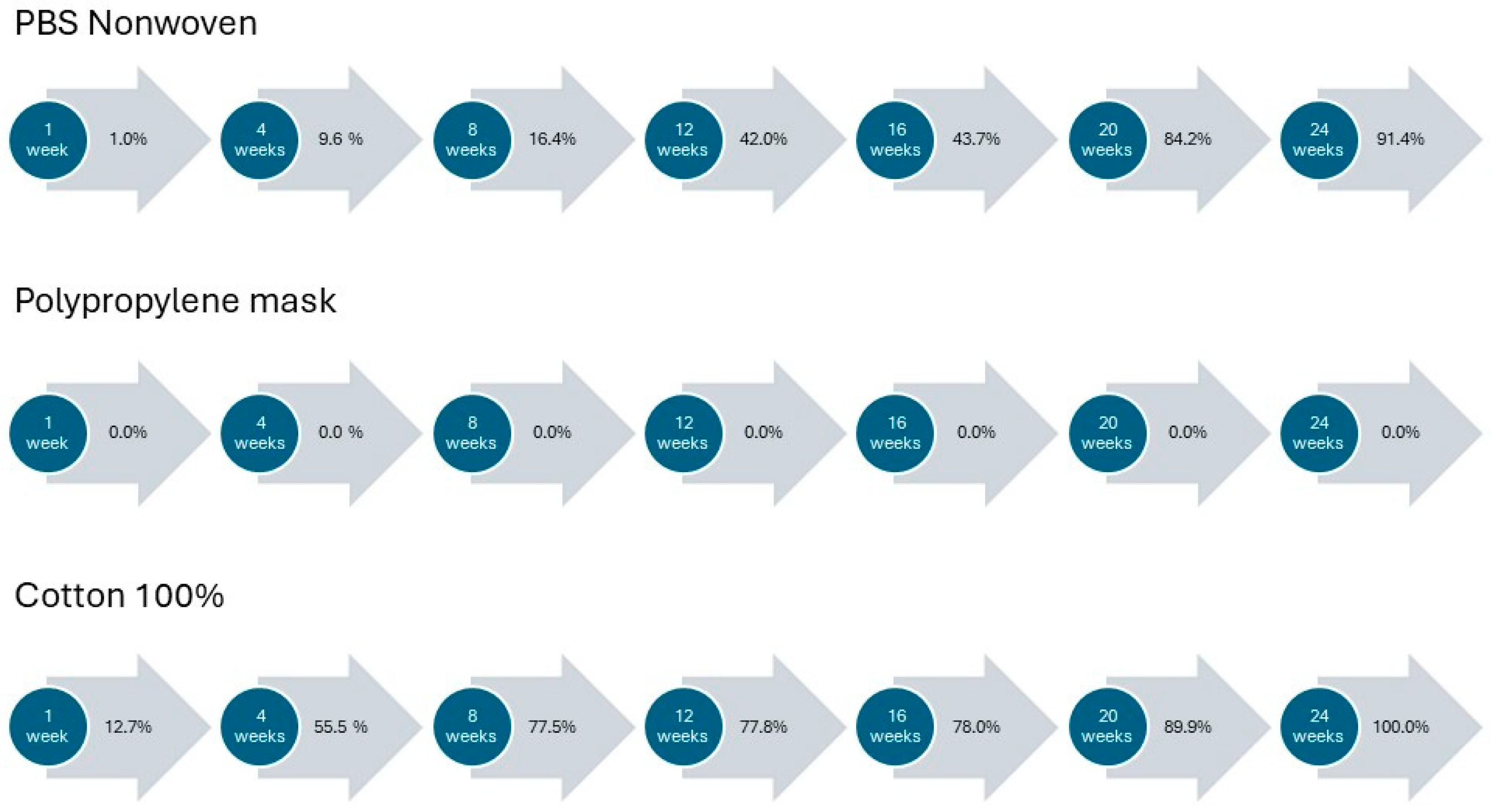
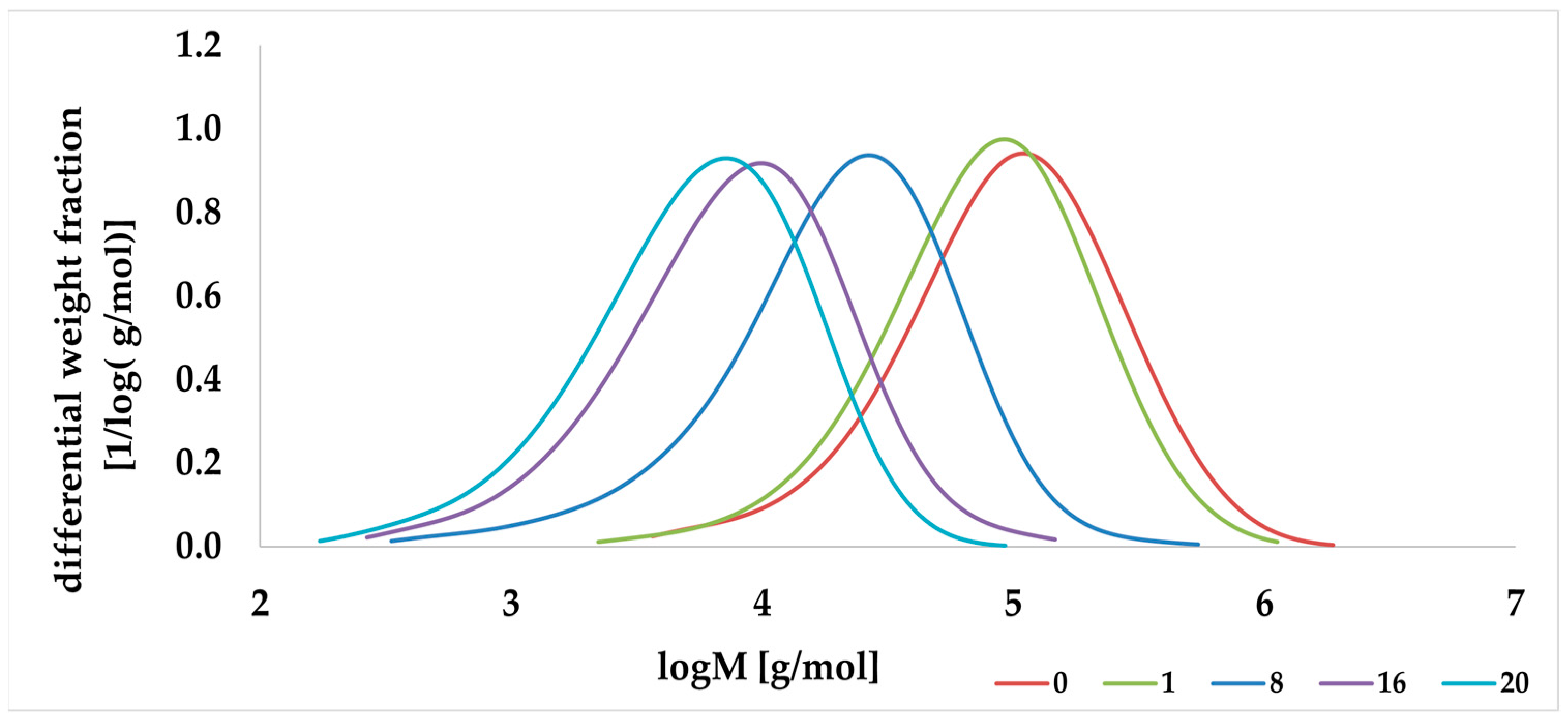
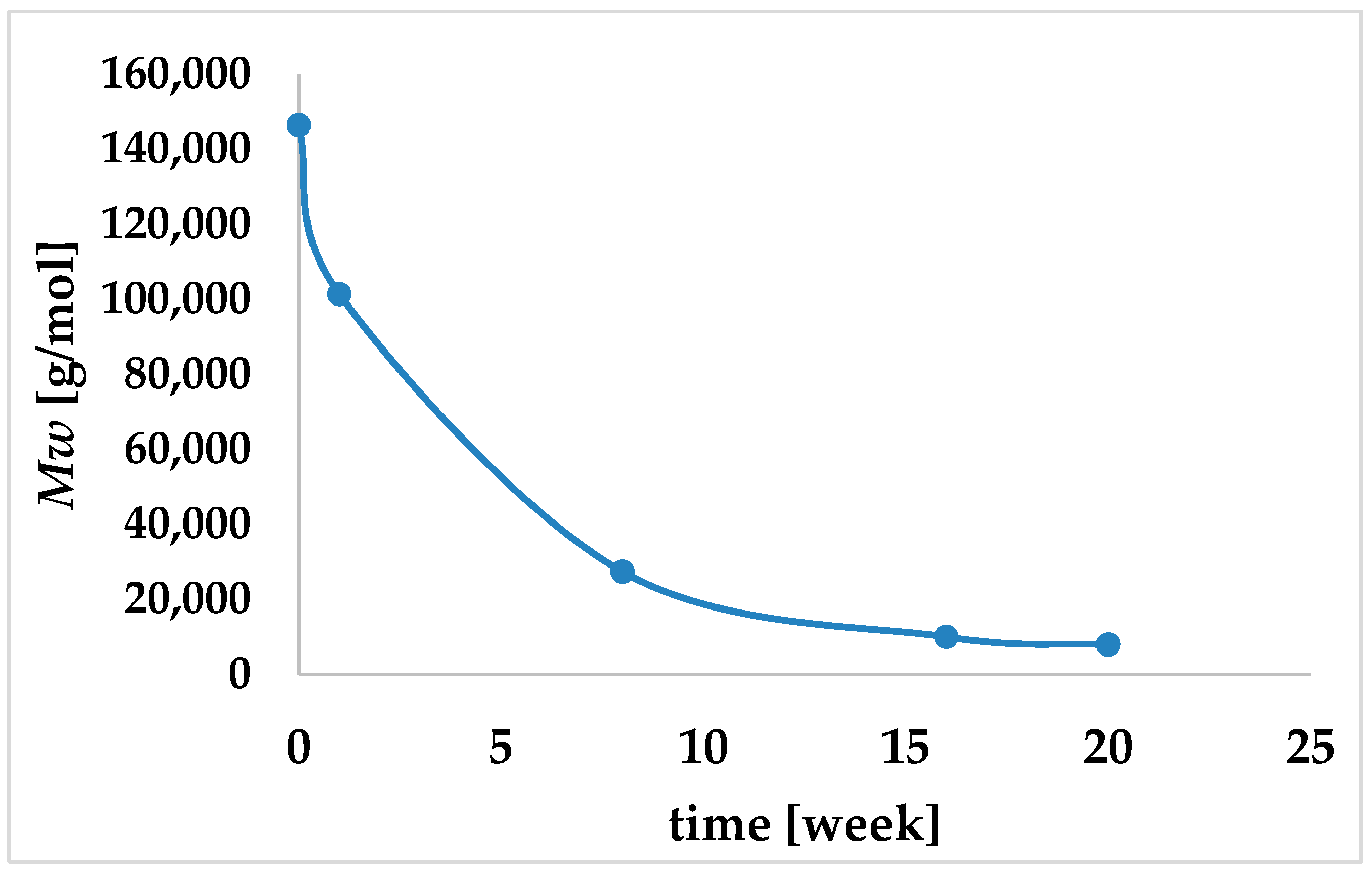

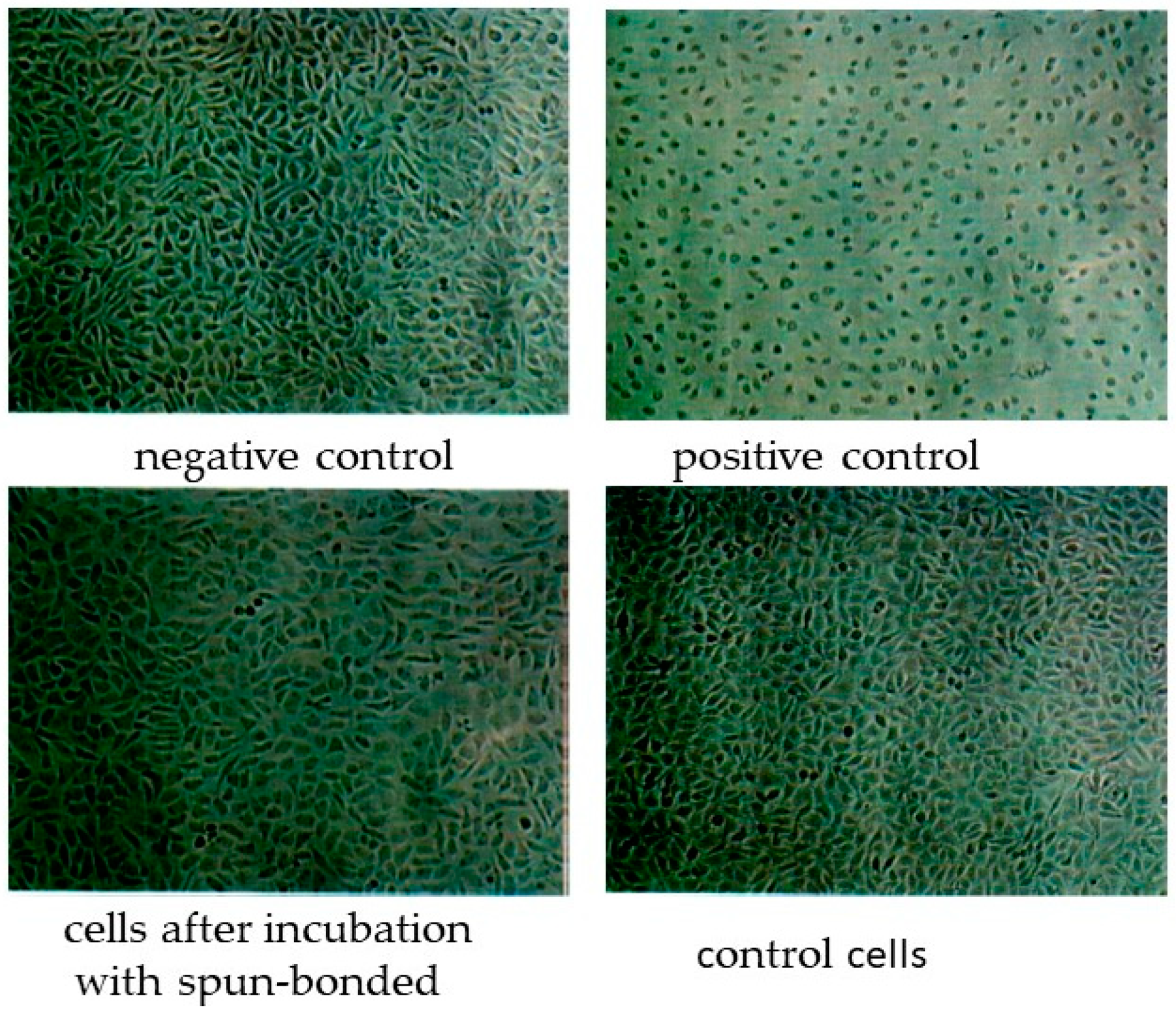
| Parameter | Spun-Bonded Nonvowen |
|---|---|
| Thickness (mm) | 0.24 ± 0.01 |
| Surface density (g/m2) | 30.9 ± 0.8 |
| Breaking force, along (N) | 32.5 ± 1.8 |
| Elongation, along (%) | 30.4 ± 6.6 |
| Tear strength, along (N) | 35.6 ± 4.7 |
| Week of Biodegradation Process | Photo Documentation | SEM ×2000 (mag) |
|---|---|---|
| 1 | 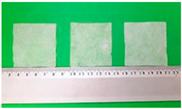 | 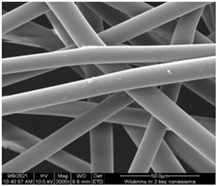 |
| 4 | 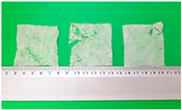 | 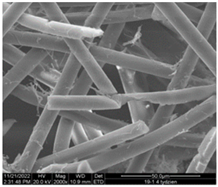 |
| 16 | 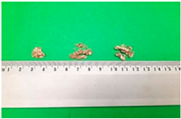 | 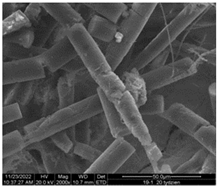 |
| 20 |  | 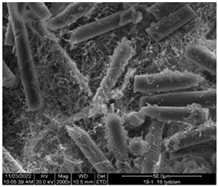 |
| 24 |  | 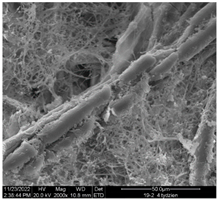 |
| Week of Biodegradation Process | Mw [g/mol] | Index Dispersion |
|---|---|---|
| 1 | 146,400 | 2.59 |
| 4 | 101,300 | 2.24 |
| 8 | 27,300 | 2.92 |
| 16 | 10,000 | 2.84 |
| 20 | 7900 | 2.74 |
| 25 | <900 | - |
Disclaimer/Publisher’s Note: The statements, opinions and data contained in all publications are solely those of the individual author(s) and contributor(s) and not of MDPI and/or the editor(s). MDPI and/or the editor(s) disclaim responsibility for any injury to people or property resulting from any ideas, methods, instructions or products referred to in the content. |
© 2024 by the authors. Licensee MDPI, Basel, Switzerland. This article is an open access article distributed under the terms and conditions of the Creative Commons Attribution (CC BY) license (https://creativecommons.org/licenses/by/4.0/).
Share and Cite
Madej-Kiełbik, L.; Jóźwik-Pruska, J.; Dziuba, R.; Gzyra-Jagieła, K.; Tarzyńska, N. The Impact of the COVID-19 Pandemic on the Amount of Plastic Waste and Alternative Materials in the Context of the Circular Economy. Sustainability 2024, 16, 1555. https://doi.org/10.3390/su16041555
Madej-Kiełbik L, Jóźwik-Pruska J, Dziuba R, Gzyra-Jagieła K, Tarzyńska N. The Impact of the COVID-19 Pandemic on the Amount of Plastic Waste and Alternative Materials in the Context of the Circular Economy. Sustainability. 2024; 16(4):1555. https://doi.org/10.3390/su16041555
Chicago/Turabian StyleMadej-Kiełbik, Longina, Jagoda Jóźwik-Pruska, Radosław Dziuba, Karolina Gzyra-Jagieła, and Nina Tarzyńska. 2024. "The Impact of the COVID-19 Pandemic on the Amount of Plastic Waste and Alternative Materials in the Context of the Circular Economy" Sustainability 16, no. 4: 1555. https://doi.org/10.3390/su16041555
APA StyleMadej-Kiełbik, L., Jóźwik-Pruska, J., Dziuba, R., Gzyra-Jagieła, K., & Tarzyńska, N. (2024). The Impact of the COVID-19 Pandemic on the Amount of Plastic Waste and Alternative Materials in the Context of the Circular Economy. Sustainability, 16(4), 1555. https://doi.org/10.3390/su16041555








